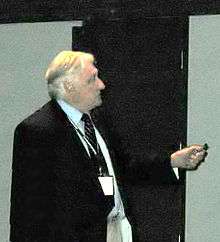Richard Bader

Richard F. W. Bader (October 15, 1931 – January 15, 2012) was a Canadian quantum chemist, noted for his work on the Atoms in molecules theory. This theory attempts to establish a physical basis for many of the working concepts of chemistry, such as atoms in molecules and bonding, in terms of the topology of the electron density function in three-dimensional space.[1]
He was born in 1931 in Kitchener, Ontario, Canada. His parents were Albert Bader and Alvina Bader, who immigrated from Switzerland.[2] His father was a butcher at Burns Pride of Canada and his mother was a housekeeper at Kitchener Hospital of Waterloo.[2] He received a scholarship from McMaster University that allowed him to earn a BSC in 1953. His father was his best supporter who encouraged him and taught him to "never quit" his education and his dream.[3] He finished his master's degree in science at McMaster University in 1955. He obtained a PhD (1958) from the Massachusetts Institute of Technology (MIT). He did postdoctoral work at MIT and the University of Cambridge. He was appointed Assistant Professor in the Department of Chemistry at the University of Ottawa in 1959 and promoted to Associate Professor in 1962. He moved to McMaster University as Associate Professor in 1963, became full Professor in 1966 and had been Emeritus Professor since 1996.[4]
He was elected a Fellow of the Royal Society of Canada in 1980.[1][5] He was a fellow of the Chemical Institute of Canada.[5] Bader has received the John Simon Guggenheim Memorial Fellowship.[5] Bader was elected a Grand Fellow of the MIRCE Akademy, Exeter, UK, in 2010.[6] Over his long career, he published 223 refereed articles and book chapters about chemistry and physics.[5] Bader's work has been cited more than 26,000 times.[5]
Richard Bader discovered that electron density is very important in explaining the behavior of atoms in the molecules.[3] According to his theory, there are no atomic orbitals in the molecules. This was a new idea and went against accepted theories. He fought hard for his revolutionary ideas and found it difficult to publish.[3] In the end, the theories became more accepted and published a book Atoms in Molecules, a Quantum Theory in 1991.[1][7] Bader said: 'We had a lot of deep discussions, and it started to occur to me that chemistry was in a real bind because we had this very powerful molecular structure hypothesis that came from the cauldron of experimental physics. But everyone had their own dictionary - different people had a different idea of what a bond was. We were trying to do science with everyone using their own private dictionary. I decided that when I left, I would make it my goal to find the physical basis of chemistry.'[4] Bader helped create the widely used software program, AIMPAC, that predicts the property of molecules based on the atoms in that molecule.[4]
Bader married Pamela Kozenof, a nurse from New Zealand, in 1958.[2] They had three daughters, Caralyn, Kimberly and Suzanna.[5] He had one grandson, Alexander.[5]
References
- 1 2 3 Obituary in Canadian Chemical News
- 1 2 3 "globeandmail.com: Scientist had the proof his thinking was correct". v1.theglobeandmail.com. Retrieved 2016-12-13.
- 1 2 3 "Mr. Bontront's Grade 12 Chemistry Wiki / Richard Bader". jeanbont.pbworks.com. Retrieved 2016-12-13.
- 1 2 3 Profile of Richard Bader
- 1 2 3 4 5 6 7 "Richard Bader, FCIC | The Chemical Institute of Canada". www.cheminst.ca. Retrieved 2016-12-13.
- ↑ MIRCE Akademy Fellows
- ↑ Bader, Richard (1994). Atoms in Molecules: A Quantum Theory. USA: Oxford University Press. ISBN 978-0-19-855865-1.